Chameleon vs Apty: Which Is Better For New Client Onboarding
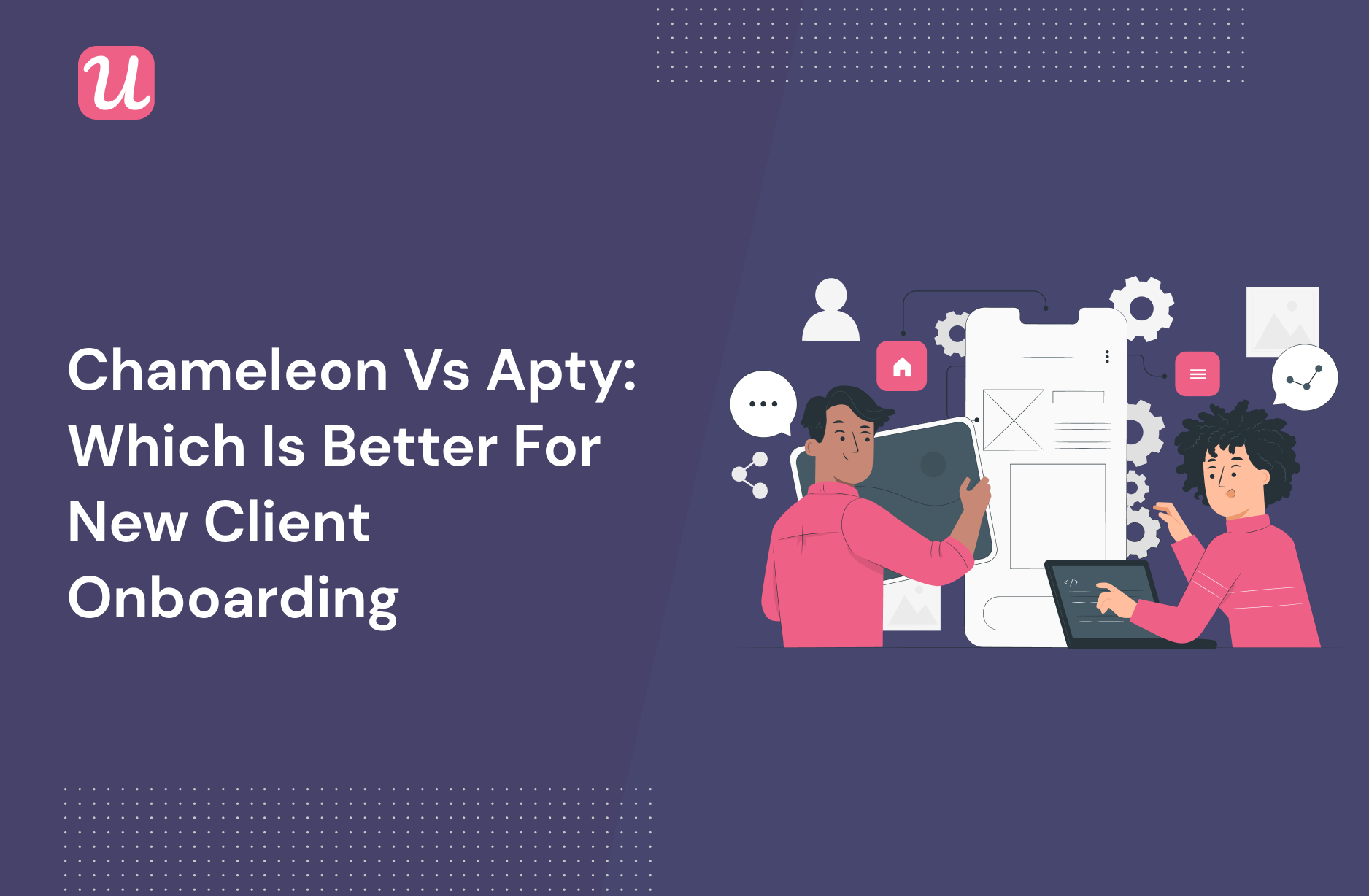
What is the best tool for onboarding new clients? Chameleon or Apty? Do you think there is better in-app onboarding software that would better match your needs?
Choosing one from so many alternatives on review sites isn’t easy.
You should consider your priorities and what functionality you’ll need from the tool. In addition, the price needs to fit your budget. Right?
Here, we’ll discuss exactly what a perfect tool for client onboarding should provide and which will be the best fit for your company.
Let’s dive in!
TL;DR
- New client onboarding involves welcoming new customers, answering their questions, and ensuring they understand what the company or product has to offer.
- For SaaS companies, onboarding is a crucial phase as it determines whether new customers stay or leave.
- In order to ensure a great first impression for your users and a smooth onboarding experience, you will need an onboarding tool. This will enable you to create interactive walkthroughs to guide customers and personalize the journey by segmenting the customer base, as well as send microsurveys to gather feedback and measure customer satisfaction.
- Chameleon and Apty are user onboarding tools that allow you to build product tours to onboard new customers. You will also get segmentation and user feedback capabilities.
- Though both are good tools in a SaaS market, they are not the right fit for everyone. For example, Chameleon doesn’t offer an in-app resource center or NPS feedback surveys which are key components for a good user onboarding tool.
- When it comes to Apty, it lacks some important UI patterns such as modals, hotspots, banners, and slideouts. There is also no user feedback collection functionality.
- There is a better alternative for Chameleon and Apty. To get more value for your money, try considering Userpilot. It’s a code-free user onboarding tool that offers you a wide range of UI patterns to create interactive and personalized onboarding experiences for new customers. You will also be offered powerful segmentation and analytics functionality to better understand and serve your customers.
![]()
Looking for the best tool for new client onboarding? Search no more!

What is new client onboarding?
New client onboarding is a process that involves welcoming new clients, answering their questions, and ensuring they understand what your company offers. It’s usually delivered by Customer Success Managers for high-touch “white glove” client onboarding and may be automated for lower-ACV prosumer customers e.g. in SaaS.
Either way, it’s the time when your company establishes the relationship with your new client/customer, so it’s critical to get things right.
New clients might feel stressed about the onboarding time, wondering about the amount of time it will take them to truly understand and adopt your service/product, and feeling buyer’s remorse – whether they made the right choice and that you’re worth their time and money.
On the flip side, your customer success agents don’t know what the cooperation with the new client will be like, what are the client’s goals, and if it will be really possible to meet their expectations.
Let’s dive deeper into why new client onboarding is important, and how to get it right!
Why should you care about new client onboarding?
The new client onboarding phase is like the first date you may have with a new “romantic interest” – it’s a make-or-break few hours that determine if the next date is going to happen. Likewise, client onboarding may not last long, but it sets the stage for your whole relationship with that client.
Here’s why it’s so critical:
- The onboarding stage is a deciding factor for a lot of your clients whether to continue business with your company or not. According to Hubspot, 63% of customers consider the onboarding process when making a purchase.
- And no wonder – as the first interactions with your team, and whether there’s a lot of friction in the onboarding process or not – determine how your client perceives your company’s service level.
- Based on that, they would probably recommend your product/service to their friends or…not. So client onboarding also affects your Word of Mouth (WOM)
- This means that a bad client onboarding experience will likely leave you with poor reviews. And reviews on review sites like G2 or Capterra are an important deciding factor for most prospects considering your tool.
- Last but not least – the client onboarding phase affects the churn likelihood of your clients. If the goals are not set right in the onboarding phase, the expectations are not managed, and your client does not feel like they are reaching success – they will be more likely to feel disappointed in your product and churn.
Why do you need tools for new client onboarding?
Wondering why you even need a new client onboarding tool? There are several reasons why you may need one:
Let’s face it: you can’t provide a premium onboarding service to every client by hand, especially if you’re growing rapidly, and you’re selling to several client sectors.
And yet – considering what we discussed in the ‘importance of client onboarding’ – you really cannot afford to drop the ball on your ‘smaller’ users. So what can you do? To conduct new client onboarding well and reduce the friction for your new clients, you need the right onboarding tools
Here’s what the right new client onboarding tool that will allow you to do:
- Provide personalized onboarding flows that will be self-serve – will reduce the time your CSMs will need to spend with your clients explaining every feature of your product.
- Segment your users by company size, role, use case, and Job-to-be-done – to make sure you can deliver the right onboarding experiences to the right person, at the right time.
- Easily conduct surveys to understand your users’ goals, motivations, expectations, JTBDs, and desired outcomes.
- Track user journeys with simple user analytics and react to any problems as they arise.
- Provide self-serve support materials right inside your product, in a resource hub.
Your new client onboarding tools will allow you to do all the above synchronously, without having to deploy an army of CSMs on every single client.
Tool’s must-have features for new client onboarding?
Before picking your new client onboarding tool, you should check if it has most of the must-have features of a good onboarding tool:
Here’s what to look for before picking your client onboarding solution:
- Great segmentation capabilities – so you can segment your new clients by size, job to be done, role, use case, etc. – but also by in-app behavior.
- Ability to create no-code microsurveys – so you can easily collect additional information about your new clients that will help you customize their onboarding flows and experience.
- Features for creating no-code in-app experiences for onboarding: onboarding flows, checklists, tooltips, and modals.
- The option to create in-app resource centers for your new clients with multimedia content hubs – including help docs, knowledge base articles, video tutorials, as well onboarding flows. The knowledge hub should be available in-app and searchable by KWs.
- User analytics to monitor new client behavior inside your product, and catch customers that are failing to achieve their goals early – to offer them more personalized “human” support.
Chameleon for new client onboarding
Chameleon is a digital adoption platform with a difference: while the other tools discussed are mostly no-code, Chameleon will require some developer involvement.
Nevertheless, it’s a powerful and effective tool that works in a similar way to Userpilot and offers similar features: styling, analytics, templates, goals, A/B testing, and checklists.
However, it doesn’t offer a resource center, or dedicated NPS, and it’s a lot worse value for money with limited features in the basic plan, which is over $150 more expensive for the same number of MAUs.
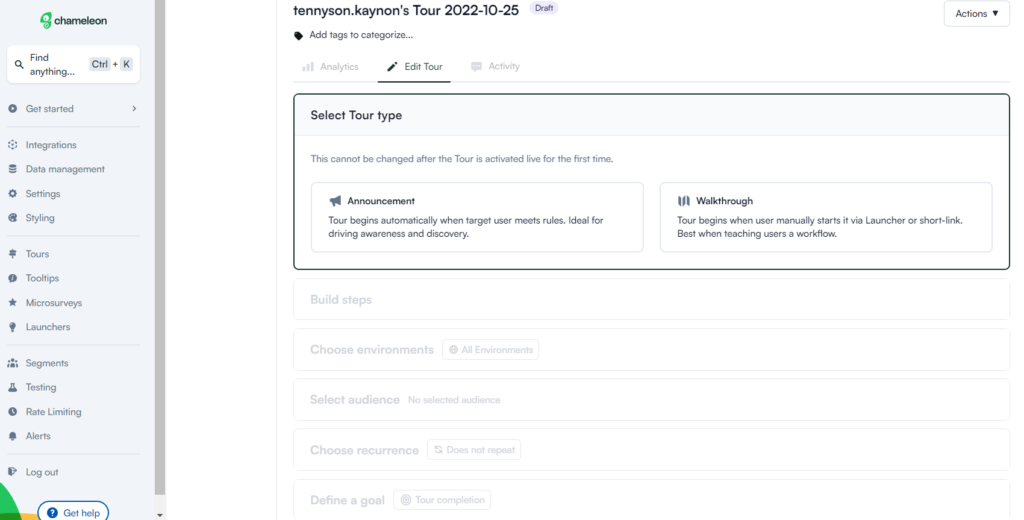
You can build widgets (launchers) and classic guides and tours with Chameleon as the main drivers of user onboarding.
Here’s how Chameleon’s main functionality helps with user onboarding:
- Chameleon’s product tours help you build flows for guidance. You can use several UI patterns for this: modals, banners, tooltips, and hotspots.
- You can customize the styling (font, color, opacity, etc) of your product tours and even add in some CSS styling if you want advanced branding.
- Launchers are where Chameleon is different compared to its competitors. These are in-app widgets that can open checklists, small help widgets, or notification centers. The downside is that you can’t have one launcher with multiple types of content.
- You can target content to different user segments based on multiple data sources including event triggering.
- Ability to use micro surveys with great customization and question-and-answer types.
- On Growth Plan and higher, you also get access to more functionality like A/B testing, multiple environments, localization (Enterprise plan only), and advanced integrations like Hubspot
All in all, Chameleon has good functionality for user onboarding but will be very limited on the Startup plan as you only get one Launcher and five micro surveys.
To build contextual and efficient user onboarding you will need more than that. Considering what you get for the money, Userpilot offers much better value.
Pros of Chameleon?
Chameleon is a robust tool for your onboarding and adoption needs. Here are the main pros to consider if you’re still deciding:
- Offers a good range of in-app messaging and UI patterns. You can create custom modals, slideouts, tooltips, hotspots, launchers (checklists or resource hub), and more.
- Good segmentation options, you can either build different user segments inside the product, or you can integrate your Chameleon account with other tools and import your data.
- Can be used on 3rd party tools, meaning you can use it for employee onboarding too.
- Offers a good range of two-way integrations: Mixpanel, Segment, Intercom, Customer.io, Segment, Hubspot, etc.
Cons of Chameleon?
While Chameleon is a great tool, the main downside is the cost and restrictions you get with it. Here are the main cons of the tool:
- There are some limitations to user onboarding flows. You can’t run multiple in-app experiences at the same time, as you can in Userpilot. Instead, Chameleon enables you to create user onboarding campaigns (different sequences of product tours shown over time).
- It’s built for single-page apps: Chameleon can’t build flows that run over multiple URLs.
- Doesn’t offer a self-service resource center where users can access multiple guides and tutorials or contact support. It does provide launchers that are similar but more restricted. A launcher can be a checklist or a list of resources, but can’t be both.
- It has a steeper learning curve and it’s not a completely no-code tool.
- The Startup (starter) plan is quite restrictive and expensive (starts at $349/mo for 2500 MAU and includes 1 Launcher only and 5 micro surveys). You will need to go for Growth ($999/mo) if you want to drive product adoption.
What users say about Chameleon?
Users appreciate Chameleon’s versatile functionalities. Let’s see what they have to say about it.
I love the variety of formats we can build in Chameleon, from interactive tooltips to progressive tours and launchers! It’s also really easy to track performance of each of these and adjust accordingly. The interface still feels quite clunky whenever I’m in build mode. For instance, I don’t like that I have to use markdown and CSS when formatting text instead of having an inline styling menu to select from. Then there’s also the issue of surveys or tour steps appearing where they’re not supposed to, apparently mistaking an element in another page for the anchor. -Nikki D
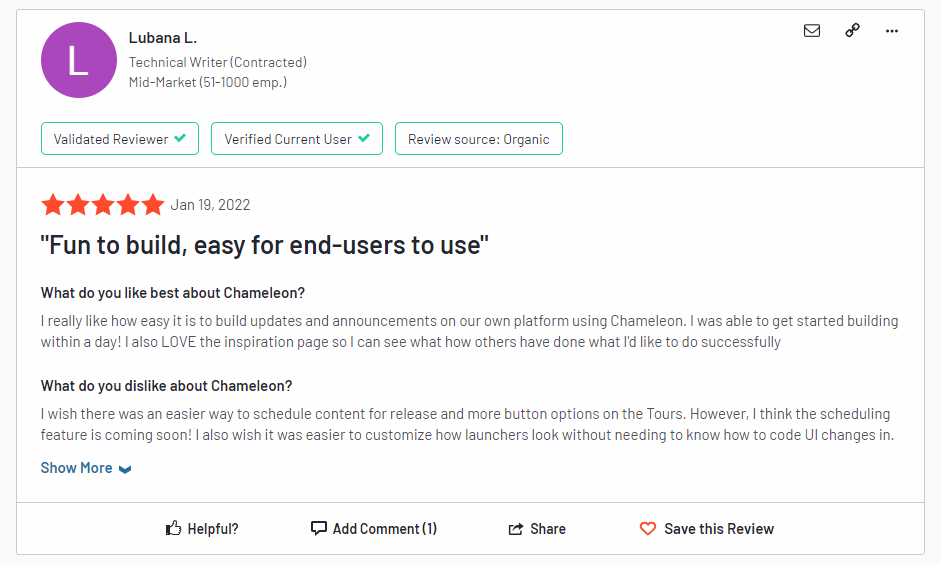
Chameleon is a good tool overall and it’s loved by its users. Most complaints are about the price and some limitations such as customization of tours and reporting and analytics.
I wish there was an easier way to schedule content for release and more button options on the Tours. However, I think the scheduling feature is coming soon! I also wish it was easier to customize how launchers look without needing to know how to code UI changes in. – Lubana L.
There is limited reporting and dashboarding functionality within Chameleon currently. – Administrator in Financial Services
I think the software is a bit on the pricey side, but since it lets us do things that we would normally need our developers to do, we are truly saving in the grand scheme of things. It means we can focus on features and bug fixes, instead of building a new communication method that would only be used internally!-Nathalie L.
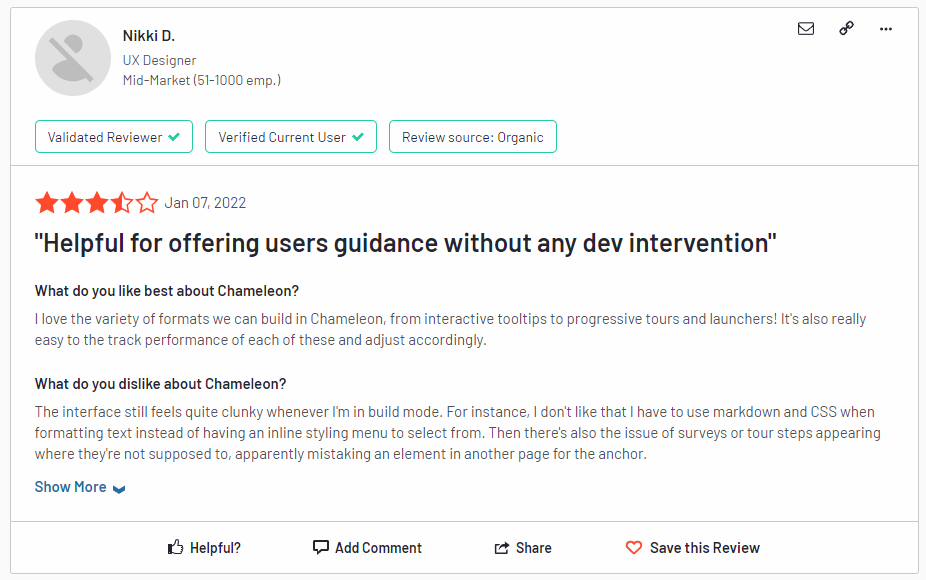
Is Chameleon the right fit for your business?
Chameleon is a great tool but we can’t say it’s the best there is. Here are three main reasons why you might consider an alternative.
- To get access to all the needed tools for proper onboarding and adoption you need to pay for the higher plans that can get expensive.
- Chameleon focuses on customization but in most cases, you will need a lot of CSS to achieve the look and feel of your brand. There are other tools that are truly no-code.
- If you need a proper product and user analytics without having to pay for extra tools and integrate with Chameleon, you might need to consider a different tool.
Chameleon pricing
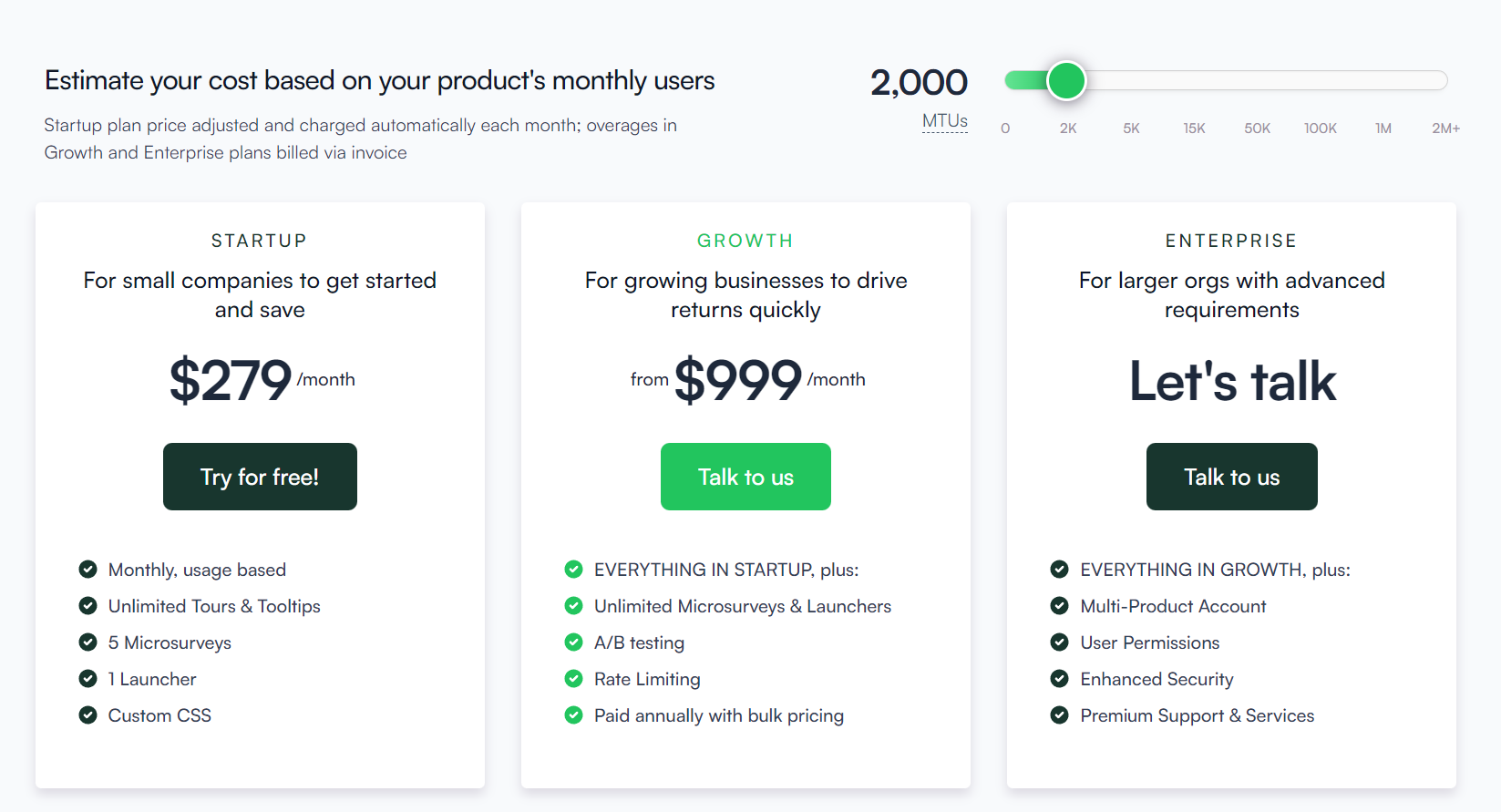
Chameleon split their pricing options primarily by the number of monthly active users, but you should keep in mind that the Startup plan also has limited features and might not be enough for interactive user onboarding and adoption for SaaS products:
- 0 – 2500 MAUs: Startup plan from $349/mo, Growth plan from $899/mo
- 2000 – 3000MAUs: Startup plan from $419/mo, Growth from $899/mo.
- 3000 – 5000 MAUs: Startup plan from $489/mo, Growth from $899/mo.
- 5000 – 10,000 MAUs: Startup plan from $517/mo, Growth from $999/mo
Disclaimer: with the Startup plan you only get 5 microsurveys and 1 launcher, no A/B testing, no Goals, and no localization.
![]()
There is a better tool for your SaaS than Chameleon!

Apty for new client onboarding
Apty’s digital adoption platform aims to make product adoption a snap with engaging onboarding flows and product tours. It does this with a mix of on-screen guidance, interactive walkthroughs, and in-app messaging.
This platform is great for engaging users on your platform to increase product adoption, feature adoption, and conversions.
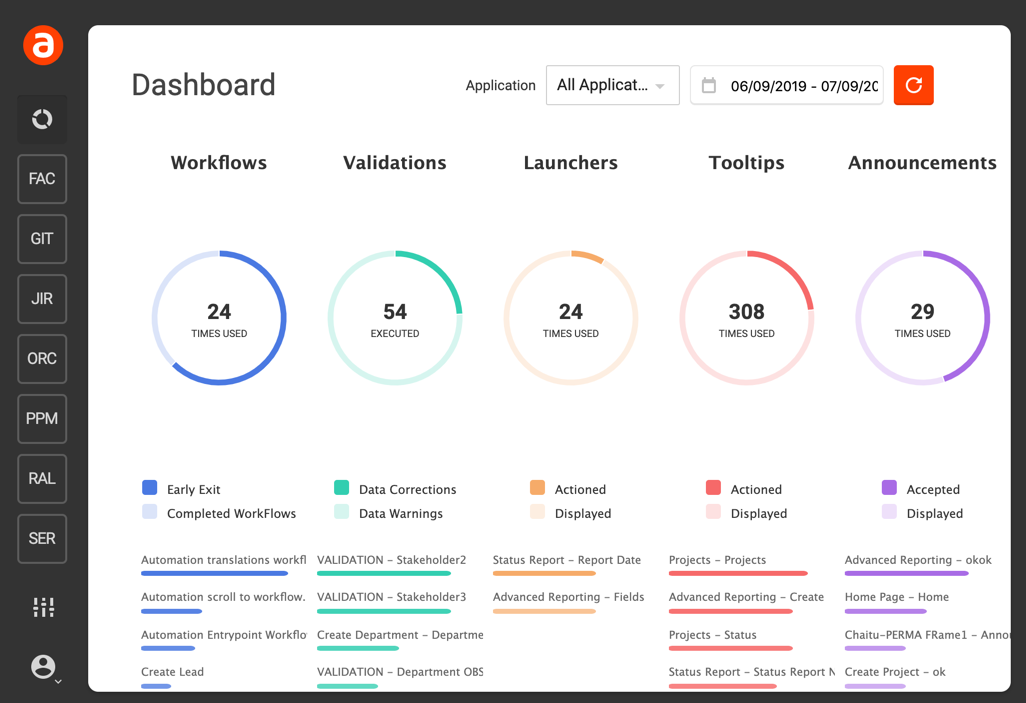
Here’s how Apty can help with user onboarding:
- Enables you to create checklists to guide users and interactive walkthroughs that simplify the onboarding process.
- It also allows you to segment users and design tailored onboarding experiences based on the role, location, and other characteristics to deliver the promised value fast.
- The goal-tracking feature allows you to set custom goals and monitor how users navigate through them. For example, you can set user activation and set it as one of your onboarding milestones to analyze progress. Then you can segment users who haven’t reached the goal and implement a number of strategies to activate them.
- Combine tooltips and create interactive walkthroughs to shorten the learning curve and, subsequently the time to value.
Pros of Apty
Apty is a robust tool for your onboarding and adoption needs. Here are the main pros to consider if you’re still deciding:
- Apty is excellent for product adoption, training, and onboarding. The tool makes it easy to develop workflows which makes development turnaround very fast-paced. In addition, it’s very simplistic to use since Apty lives in the browser as an extension.
- You can either build different user segments inside the product, or you can integrate your Apty account with other tools and import your data.
- Can be used on 3rd party tools, meaning you can use it for employee onboarding too.
Cons of Apty
While Apty is a great tool, the main downsides are the cost and restrictions you get with it. Here are the main cons of the tool:
- Apty offers tooltips and checklists for building product experience flows, but unlike other similar tools, it lacks some important UI patterns such as modals, hotspots, banners, and slideouts.
- One of the biggest disadvantages of Apty is the absence of in-app customer feedback collection. In-app surveys help you collect user insights at scale and improve the product to match user expectations. Without feedback and user input, you are missing out on a lot.
- Doesn’t offer self-service support like a help center where users can access multiple guides and tutorials or contact support. It does provide guides that are similar but more restricted.
What users say about Apty?
Overall, users feel positive about Apty– here’s an example summarizing some key points about its features and the value it offers:
Our Apty Representative, Joe Fimiani, is one of the main reasons we love working with Apty. Joe works hard to establish a trusting relationship with his customers. Joe goes above and beyond to ensure we are satisfied and happy with our Apty product by doing regular check-ins.One thing that is a little frustrating is getting past the Apty pop-up widgets. Sometimes the pop-up widgets are in the way of tabs that need to be selected. As a result, the tabs are harder to select. However, this may not be an Apty issue, rather a Clarity issue 🙂 –
Desiree G.
Apty is incredibly helpful for new employees to get familiar with processes in our project management software. The work flows and tooltips have been essential for our workforce.The only downside to Apty was the learning curve of first building out the application to work with our project management tool. Apty had a great support system to help through those challenges. – Jennifer T
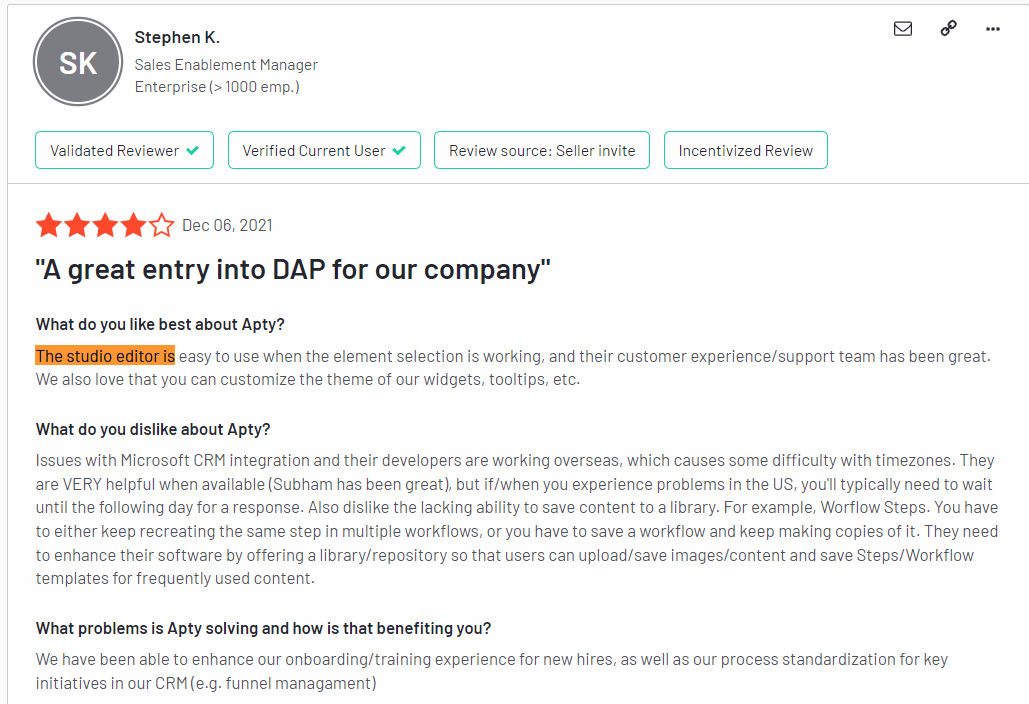
Most complaints are about the missing features, integrations, and the steep learning curve.
It’s tricky to make the most of it, particularly in the early stages of adoption. The support team are great, but it can be challenging to know what support can be asked for if we’re unaware of what’s possible.- Administrator in Business Supplies and Equipment
With each new release of the software, there is a bit of uncertainty in the stability of new features. Requires more attention than preferable with each new switch. Also, our tools are more complex than your standard website and that requires more work and work-arounds than expected when first acquiring a third-party onboarding tool.- Administrator in Computer Software
UX experience when it comes to testing is cumbersome; a lot of back and forth.
Below are critical tools that are missing or need improvement. I would like to see these additions and enhancements as current features are limiting our options for solutions: Auto triggers (Related to Rule Engine, i.e. Specific page load, removing the reliance on triggers such as: Launchers, Menu Widget, and Announcement Button),IDP for standardized User Identifier,eLearning for content creators (Builder Certifications),Surveys,Chatbot etc- Paolo T.
Is Apty the right fit for your business?
Apty is a great tool but has limited usability. Here are three main reasons why you might consider an alternative:
- To get access to all the needed tools for proper onboarding and adoption you need to pay for the higher plans that can get quite expensive.
- Apty doesn’t offer user feedback surveys, which are a very effective way to collect user sentiment at scale and improve your product experiences to meet customer expectations. So if you are aiming to be a customer-centric company that puts users and their needs at the heart of the business, you may need to choose another tool
- Although Apty offers some segmentation options, in Userpilot you can group users on many more attributes and create more advanced segments.
Apty pricing
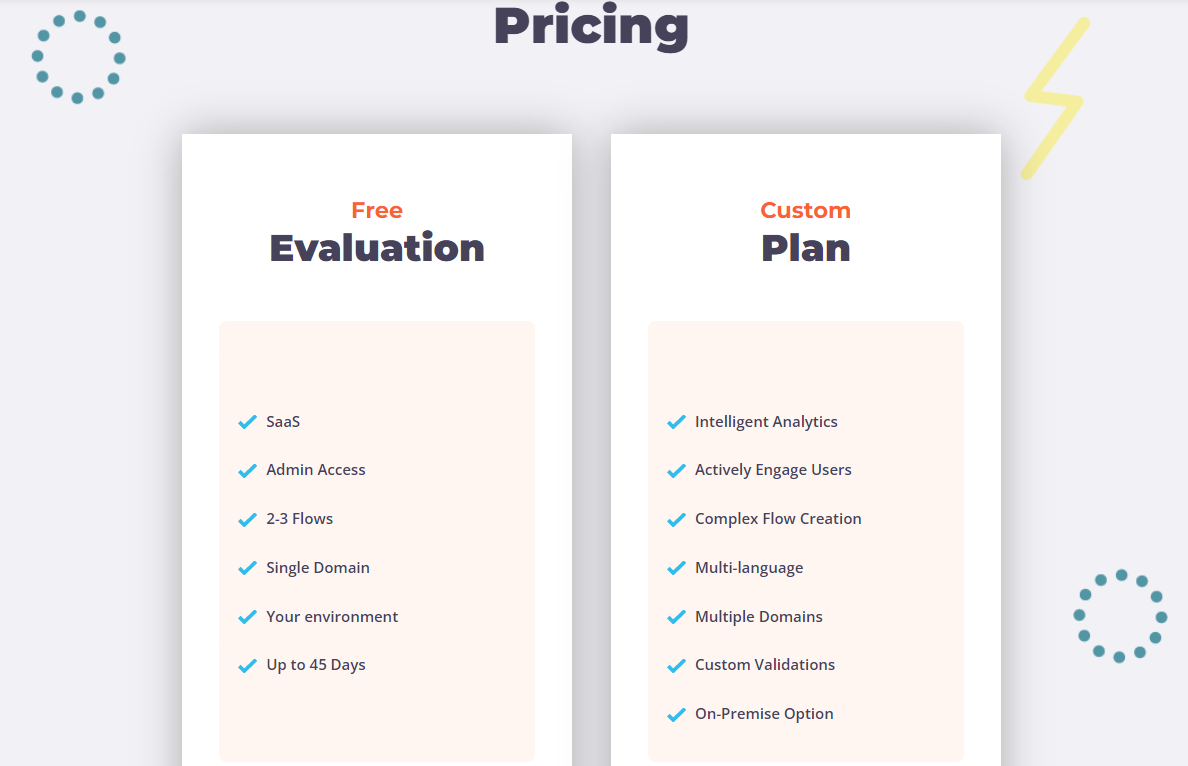
Apty offers a free trial and custom quotes based on business needs.
- Free trial: Up to 45 days, includes 2-3 flows, works on a single domain.
- Custom pricing: Intelligent analytics, complex flow creation, multilingual support, available on multiple domains.
![]()
There is a better tool for your SaaS than Apty!

Is there a better alternative for new client onboarding?
Chameleon and Apty are good tools for new client onboarding. We’ve seen how they compare to each other and what you can achieve with them. Call us biased, but if you’re looking for something better, Userpilot offers more value for your money than these tools.
Userpilot for new client onboarding
Userpilot is a powerful product adoption platform that enables you to quickly build personalized, flexible, contextually relevant in-app experiences targeted to different user segments – all without writing a line of code.
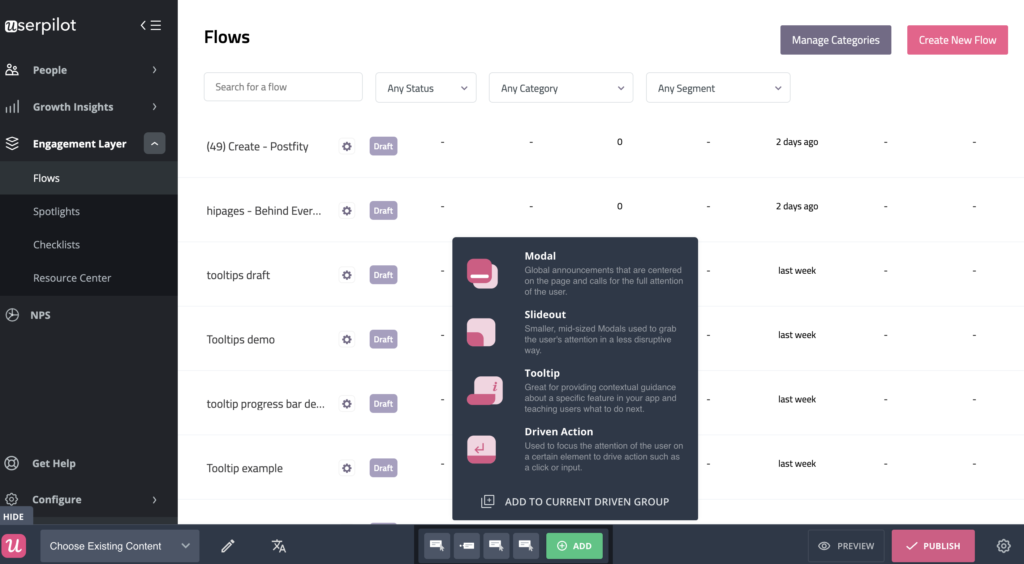
Userpilot was built specifically for SaaS product teams that want to improve their user onboarding experience and boost user activation.
You can build a huge variety of user onboarding experiences and in-app guidance flows without needing to code.
Here’s what you’ll get when you start using Userpilot:
- Forget about coding in-app experiences: Userpilot is a no-code solution and only requires your dev to install a line of javascript inside your app and for you to download a chrome extension that opens up the visual builder.
- Build in-app flows using the largest range of UI patterns (modals, slideouts, tooltips, hotspots, banners) and in-app onboarding experiences (checklists, microsurveys, NPS surveys, in-app resource center)
- Get access to a built-in NPS tool for collecting and analyzing user sentiment so you can improve your onboarding process based on real data.
- Create and track combinations of in-app events like clicks, hovers and form fills, and then analyze all these interactions under your own custom events, which can be built without code or API calls.
- Use advanced product analytics and in-app flows analytics to identify where users need help and create granular user segments to trigger in-app experiences contextually (segment based on user identification data, in-app engagement, custom events, clicks, hovers, form fills, user feedback responses, NPS scores and more)
- Enhance the onboarding experience with in-app help by launching a Resource Center directly inside your app. Add in-app guides, and video tutorials, and give users access to search the knowledge base or reach out to support. Self-service has never been easier.
The best user onboarding is contextual and it happens right where the users need it, inside your app. There isn’t a better user onboarding tool out there that offers more value for the money than Userpilot.
Schedule a demo with our team and get ready to build the best onboarding experiences your users have seen.
Pros of Userpilot
Userpilot has a number of advantages, especially for mid-market SaaS companies looking for a robust but at the same time very easy-to-use, no-code tool for user onboarding, product adoption, and simplified product analytics. Let’s have a look at the pros of using Userpilot:
- No-code builder – Userpilot comes with an easy-to-use Chrome Extension builder.
- Multiple UI patterns – choose from a range of options to build customized flows: modals,
- slideouts, banners, tooltips, hotspots, and checklists are all at your disposal.
- UI patterns are not limited by plan – you get access to all of them on every single plan, meaning you get value even with the Traction plan (this is the entry-level one).
- Engaging walkthroughs and onboarding flows- build interactive walkthroughs targeted to distinct user segments.
- In-app help – build a resource center offering self-service support to your users, customize it with your branding, and select from a range of help options to boost user satisfaction (i.e. videos, in-app flows, chat, and more).
- Experimentation – built-in A/B testing for flows lets you explore and quickly iterate based on direct user behavior.
- Powerful feedback options- integrated NPS surveys with analytics and response tagging unlock insight into how your users feel.
- Advanced analytics and segmentation- analyze product usage and in-app flow engagement and build user segments using the data.
- Event tracking and feature tags- tag UI engagement (clicks, form fills, hovers) and group them into one custom event to track what really matters.
- More value with integrations- unlock value faster with built-in integrations with popular tools like Segment, Amplitude, Mixpanel, Kissmetrics, Intercom, Heap, and more.
Cons of Userpilot
Userpilot has a number of advantages, especially for mid-market SaaS companies looking for a robust but at the same time very easy-to-use, no-code tool for user onboarding, product adoption, and simplified product analytics. Let’s have a look at the pros of using Userpilot:
- No-code builder – Userpilot comes with an easy-to-use Chrome Extension builder.
- Multiple UI patterns – choose from a range of options to build customized flows: modals,
- slideouts, banners, tooltips, hotspots, and checklists are all at your disposal.
- UI patterns are not limited by plan – you get access to all of them on every single plan, meaning you get value even with the Traction plan (this is the entry-level one).
- Engaging walkthroughs and onboarding flows- build interactive walkthroughs targeted to distinct user segments.
- In-app help – build a resource center offering self-service support to your users, customize it with your branding, and select from a range of help options to boost user satisfaction (i.e. videos, in-app flows, chat, and more).
- Experimentation – built-in A/B testing for flows lets you explore and quickly iterate based on direct user behavior.
- Powerful feedback options- integrated NPS surveys with analytics and response tagging unlock insight into how your users feel.
- Advanced analytics and segmentation- analyze product usage and in-app flow engagement and build user segments using the data.
- Event tracking and feature tags- tag UI engagement (clicks, form fills, hovers) and group them into one custom event to track what really matters.
- More value with integrations- unlock value faster with built-in integrations with popular tools like Segment, Amplitude, Mixpanel, Kissmetrics, Intercom, Heap, and more.
What users say about Userpilot

Let’s check what real users like about Userpilot.
Userpilot is an incredible, user-friendly software that allows us to create unforgettable experiences for our clients! From basic to complex experiences, we have been able to do them all with ease! I would highly recommend this software to anyone who wants to provide their clients or users with the best product tour experience. The possibilities of what you can create are endless! – Tayla G.
Userpilot is simple to set up, use, and does not require any dev – which means instant publishing. This is critical for us as a SaaS company that releases new features frequently; we need the ability to inform our customers of changes quickly, and doing this in our platform through Userpilot allows us to reach the right audience, at the right time, in the right place. There have been many awesome extra features we’ve discovered since coming on board, and it’s been great to see new features released frequently. The tool itself is intuitive and reliable. Having used similar products previously that were clunky and buggy this has really made us happy with our decision to move to Userpilot. – Melina K.
![]()
Get more value for your money with Userpilot!

Userpilot pricing
Userpilot’s transparent pricing ranges from $249/month on the entry-level end to an Enterprise tier for larger companies.
Furthermore, Userpilot’s entry-level plan includes access to all UI patterns and should include everything that most mid-market SaaS businesses need to get started.

Userpilot has three paid plans to choose from:
- Starter: The entry-level Starter plan starts at $249/month and includes features like segmentation, product analytics, reporting, user engagement, NPS feedback, and customization.
- Growth: The Growth plan starts at $749/month and includes features like resource centers, advanced event-based triggers, unlimited feature tagging, AI-powered content localization, EU hosting options, and a dedicated customer success manager.
- Enterprise: The Enterprise plan uses custom pricing and includes all the features from Starter + Growth plus custom roles/permissions, access to premium integrations, priority support, custom contract, SLA, SAML SSO, activity logs, security audit, and compliance (SOC 2/GDPR).
Conclusion
There you have it. It should be easier now to make an informed decision between Chameleon and Apty.
Both tools come with advantages and disadvantages so there isn’t one that is the best. It will depend on your product and current needs. If you want the best value for money, going with the alternative option would be our recommendation.
Want to see how Userpilot can help with new client onboarding? Book a demo below.
![]()
There is a better tool for your SaaS than Chameleon!


